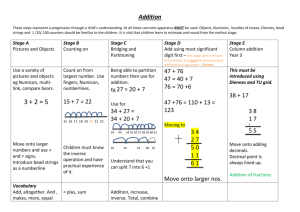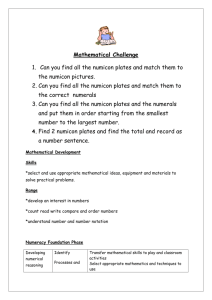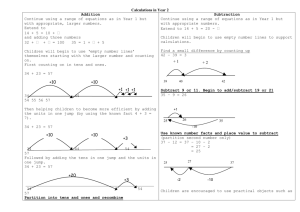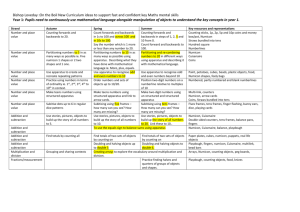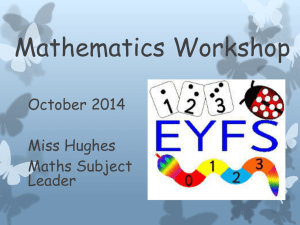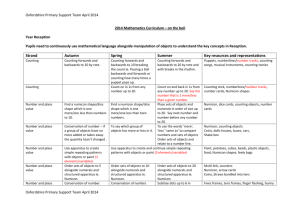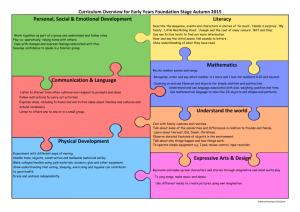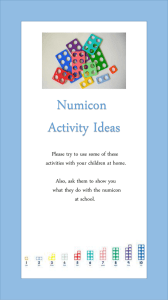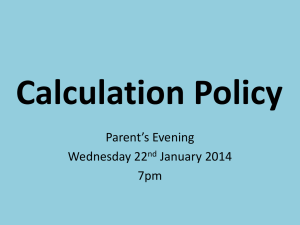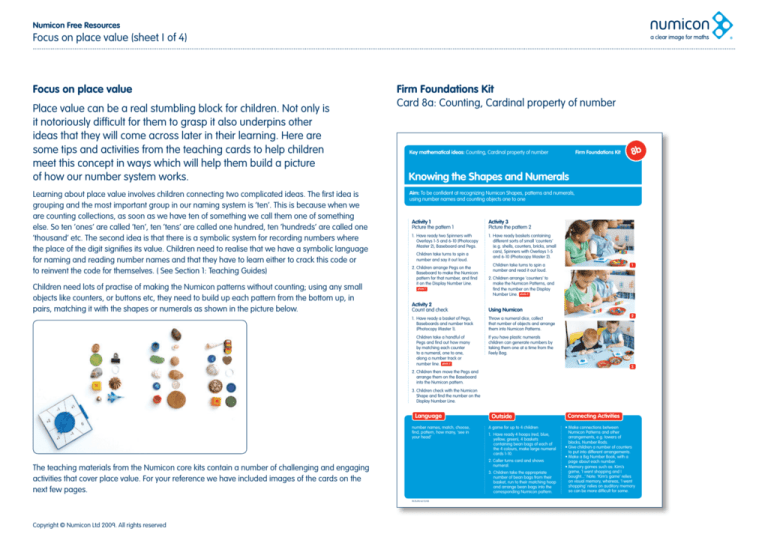
Numicon Free Resources
Focus on place value (sheet 1 of 4)
Focus on place value
Place value can be a real stumbling block for children. Not only is
it notoriously difficult for them to grasp it also underpins other
ideas that they will come across later in their learning. Here are
some tips and activities from the teaching cards to help children
meet this concept in ways which will help them build a picture
of how our number system works.
Learning about place value involves children connecting two complicated ideas. The first idea is
grouping and the most important group in our naming system is ‘ten’. This is because when we
are counting collections, as soon as we have ten of something we call them one of something
else. So ten ‘ones’ are called ‘ten’, ten ‘tens’ are called one hundred, ten ‘hundreds’ are called one
‘thousand’ etc. The second idea is that there is a symbolic system for recording numbers where
the place of the digit signifies its value. Children need to realise that we have a symbolic language
for naming and reading number names and that they have to learn either to crack this code or
to reinvent the code for themselves. ( See Section 1: Teaching Guides)
Children need lots of practise of making the Numicon patterns without counting; using any small
objects like counters, or buttons etc, they need to build up each pattern from the bottom up, in
pairs, matching it with the shapes or numerals as shown in the picture below.
Firm Foundations Kit
Card 8a: Counting, Cardinal property of number
Firm Foundations Kit
Key mathematical ideas: Counting, Cardinal property of number
8b
Knowing the Shapes and Numerals
Aim: To be confident at recognizing Numicon Shapes, patterns and numerals,
using number names and counting objects one to one
Activity 1
Picture the pattern 1
Activity 3
Picture the pattern 2
1. Have ready two Spinners with
Overlays 1-5 and 6-10 (Photocopy
Master 2), Baseboard and Pegs.
1. Have ready baskets containing
different sorts of small ‘counters’
(e.g. shells, counters, bricks, small
cars), Spinners with Overlays 1-5
and 6-10 (Photocopy Master 2).
Children take turns to spin a
number and say it out loud.
2. Children arrange Pegs on the
Baseboard to make the Numicon
pattern for that number, and find
it on the Display Number Line.
photo 1
Children take turns to spin a
number and read it out loud.
1
2. Children arrange ‘counters’ to
make the Numicon Patterns, and
find the number on the Display
Number Line. photo 3
Activity 2
Count and check
Using Numicon
1. Have ready a basket of Pegs,
Baseboards and number track
(Photocopy Master 1).
Throw a numeral dice, collect
that number of objects and arrange
them into Numicon Patterns.
Children take a handful of
Pegs and find out how many
by matching each counter
to a numeral, one to one,
along a number track or
number line. photo 2
If you have plastic numerals
children can generate numbers by
taking them one at a time from the
Feely Bag.
2
3
2. Children then move the Pegs and
arrange them on the Baseboard
into the Numicon pattern.
3. Children check with the Numicon
Shape and find the number on the
Display Number Line.
Language
number names, match, choose,
find, pattern, how many, ‘see in
your head’
Outside
A game for up to 4 children
1. Have ready 4 hoops (red, blue,
yellow, green), 4 baskets
containing bean bags of each of
the 4 colours, make large numeral
cards 1-10.
2. Caller turns card and shows
numeral.
The teaching materials from the Numicon core kits contain a number of challenging and engaging
activities that cover place value. For your reference we have included images of the cards on the
next few pages.
3. Children take the appropriate
number of bean bags from their
basket, run to their matching hoop
and arrange bean bags into the
corresponding Numicon pattern.
Connecting Activities
• Make connections between
Numicon Patterns and other
arrangements, e.g. towers of
blocks, Number Rods.
• Give children a number of counters
to put into different arrangements.
• Make a Big Number Book, with a
page about each number.
• Memory games such as: Kim’s
game, ‘I went shopping and I
bought...’ Note: ‘Kim’s game’ relies
on visual memory, whereas, ‘I went
shopping’ relies on auditory memory
so can be more difficult for some.
FK/SUFK/v2/12/08
BINDF_ACTIVITIES.indd 16
Copyright © Numicon Ltd 2009. All rights reserved
8/1/09 14:21:34
Numicon Free Resources
Focus on place value (sheet 2 of 4)
Kit 1, Numbers and the Number System
Card 3A: Find how many without counting
Kit1_CardsV4a.qxd:Layout 1
1/10/08
10:10
Kit 1, Numbers and the Number System
Card 3B: Counting by grouping in tens
Page 17
Kit1_CardsV4a.qxd:Layout 1
Key mathematical idea Counting, Place value, Pattern
Kit 1 Numbers and The Number System 3A
Finding how many without counting
1/10/08
10:10
Page 18
Key mathematical idea Counting and place value, Pattern
Kit 1 Numbers and The Number System 3B
Counting by grouping in tens
Aims
Language
Aims
Language
To reinforce understanding that arranging counters into
patterns and groups is an efficient way to find out ‘how
many’ without counting.
To extend counting range.
To introduce place value.
count, how many, number names, arrange, pattern,
check, estimate
To reinforce understanding that arranging counters into
patterns and groups is an efficient way to find out ‘how
many’ without counting.
To extend counting range.
To begin to understand place value.
count, how many, number names, check, estimate, tens,
units
Activity 1
Activity 1
Step 1
• Teacher puts out Numicon Shapes 1-10 in order, a basket
with 20 Pegs and a Baseboard.
• Teacher asks children to close their eyes and puts some
Pegs from the basket over the Baseboard.
Step 1
• Teacher puts out a sheet of wrapping paper, basket of
Pegs or other objects, 0-100 Number Line, tens Number
Cards from 0-100 Pack.
• Teacher shows children the wrapping paper and asks
them how many pictures they think there are.
Step 2
Teacher with children put one Peg on each picture.
• When all the tens have been counted, arrange the last
few Pegs into a Numicon pattern. Children can now see
how many have been counted altogether.
• Children find the last number in the count on the
number line.
Activity 2
Step 2
• Children open their eyes and teacher asks them to
rearrange the Pegs into the 10-pattern and the pattern
for ‘whatever is left’ without counting.
• Children say how many Pegs there are from looking at
the patterns.
Step 3
• Children check the answer is correct by fixing the
equivalent Shapes on top of the Pegs.
• Teacher asks children to find the number on a number
line (matching the Shapes to the Display Number Line if
necessary).
© Numicon 2006. All rights reserved.
Step 1
Teacher shows children a collection of up to 20 Pegs and
asks them to think how many Pegs there are.
Step 2
Teacher asks children to find the Numicon Shapes that
show their estimation.
Step 3
Teacher puts the Pegs into two 10-shapes, asks children
to say how many and check their estimate.
Use it!
Mental arithmetic
Ask children to estimate how many Pegs on the
Baseboard before arranging into patterns.
Independent practice
For children working in pairs – Have ready a basket with
up to 30 Pegs, Baseboard, Numicon Shapes.
• Children practise the above activity.
For children working in pairs – Have ready baskets of 20
objects.
• Children take out a handful of objects and find out how
many there are without counting, by arranging them into
Numicon patterns on the table.
Activity 2
Step 3
• Children remove Pegs and arrange them into
patterns of 10.
• When one pattern of 10 is complete, teacher asks
children to put the ‘10’ Card and below the pattern.
Children find 10 on the Number Line.
Use it!
Key questions for assessment
• Can children arrange objects into Numicon patterns
without using the Baseboard?
• From looking at the patterns can children say how many
tens there are in the number they have made?
www.numicon.com
Repeat Activity 1 using 1p coins as counters. Children
exchange each 10 pattern for a 10p coin and then find the
total.
Step 4
• Teacher continues to guide the children through each 10,
each time putting down the next tens Number Card and
finding its place on the Number Line.
© Numicon 2006. All rights reserved.
• Give children frequent opportunities to count by
arranging objects into patterns.
• Give opportunities for children to estimate how many in
counting situations.
• Use the patterns in data handling situations.
Key questions for assessment
• Having arranged the counters, can children say how
many tens there are from looking at the patterns?
• Can the children make a sensible estimate?
www.numicon.com
Numicon Free Resources
Focus on place value (sheet 3 of 4)
Kit 2, Numbers and the Number System
Card 7: Visualising – developing mental imagery
Kit2_CardsV7(250gsm)_revised2.qxd:Layout 1
10/9/09
13:41
Page 31
Key mathematical idea Ordinal property of numbers, Place value
Kit2_CardsV7(250gsm)_revised2.qxd:Layout 1
Kit 2 Numbers and The Number System 7
Visualising – developing mental imagery
Aims
Language
To recall by visualisation the structure and value
of numbers.
To compare and order numbers from 1-100.
To understand ‘between’ in the context of
multiples of 10.
tens, units, more, less, between, smaller, greater, before,
after, forwards, backwards, adding one,
subtracting/taking away one, multiple of ten
Activity 1
Step 2
Teacher asks children how to make the number
with Numicon Shapes and puts out the 10-shape and
6-shape. Teacher now asks children which multiple of
ten comes after 16 and then asks them how many
more are needed to reach 20. The teacher adds the
4-shape to the 16 to check.
Step 1
Teacher says a number between 1-100.
Step 2
Children (using white boards or paper) write the numeral
and from memory, draw the appropriate tens and units
patterns of Numicon Shapes.
Step 3
Teacher picks another number. Children draw the pattern
and compare with the previous number to see which is
greater or smaller.
13:41
Step 4
• Children choose a number in between and draw
the pattern.
• Find all three numbers on the 0-100 Number Line.
Kit 2 Numbers and The Number System 7
Aims
Language
To recall by visualisation the structure and value
of numbers.
To compare and order numbers from 1-100.
To understand ‘between’ in the context of
multiples of 10.
tens, units, more, less, between, smaller, greater,
before, after, forwards, backwards, adding one,
subtracting/taking away one, multiple of ten
Step 1
• Make 16 again and find out which multiple of 10 comes
before by removing the 6.
• Check by laying Shapes along the Numicon Tens
Number Line.
Step 2
Record steps on an empty number line.
Independent practice
Individual work
Child repeats Activity 3 generating numbers from the
0-100 Number Cards.
Game for 2 players
• Have ready Feely Bag containing nine 10-shapes and
one of each of the other Shapes.
• Player 1 chooses some Shapes from the Feely Bag to
make a 2-digit number and places them on the table.
• Player 2 says what has been made, draws an empty
number line and records the number.
• Player 1 now adds the correct Shape to make the
next multiple of 10 and records this by jotting on the
empty number line.
Key questions
• Can you put these numbers in order from the smallest
to the largest?
• Do you know the multiple of ten that comes between
34 and 42?
Activity 2
Step 1
Teacher says a number e.g. 16, holds up an imaginary
10-shape and 6-shape, and asks children to visualise
them in their mind’s eye.
Continued overleaf
Page 32
Key mathematical idea Ordinal property of numbers, Place value
Activity 3
Step 3
Lay the Shapes along the Numicon Tens Number Line.
Step 4
Record steps on an empty number line.
©Numicon 2008. All rights reserved.
www.numicon.com
10/9/09
©Numicon 2008. All rights reserved.
www.numicon.com
Numicon Free Resources
Focus on place value (sheet 4 of 4)
Kit 2, Numbers and the Number System
Card 8: Visualising – developing mental imagery
Kit2_CardsV7(250gsm)_revised2.qxd:Layout 1
10/9/09
13:41
Page 33
Key mathematical idea Place value
Kit 2 Numbers and The Number System 8
Partitioning 2-digit numbers into a multiple of 10 and 1s
Aim
Language
To partition 2-digit numbers into a multiple of 10 and 1s.
partition, tens, units, add, equals, arrange, 2-digit
number, multiple of 10
Activity 1
Step 1
• Teacher builds a two digit number e.g. 43 with four
10-shapes and a 3-shape (or with four 10-rods and
three 1-rods arranged into Numicon ‘3-shape pattern’).
Children say the number.
• Teacher reminds children how to ‘partition’ the number
showing how the number can be separated into tens
and units and saying ‘4 tens and 3 units’.
Step 4
• Teacher points to apparatus and says “40 add 3
equals 43” and “43 equals 40 + 3” and asks children
how to write the whole number sentence. Teacher
writes 40 + 3 = 43 and 43 = 40 + 3.
• Teacher gives children an empty number line and asks
children to record the addition with jottings.
Step 2
Children then say ‘4 tens and 3 units’ and write it on a
piece of paper, placing it below the apparatus.
Independent practice
Step 3
Teacher discusses with children how ‘4 tens and 3 units’ is
written in numerals and using cards, place ‘40’ under the
tens and ‘3’ under the units.
Individual
Using 0-100 Cards and a Tens and Units Frame
(photocopy master 8) children take a Card and build the
number with either Numicon Shapes or Number Rods.
Record partitioning as an addition.
Game for two players
• Have ready Numicon Shapes or Number Rods.
• Player 1 makes a number from apparatus.
• Player 2 says how many tens and how many units.
• Both players record the addition facts e.g. 40 + 3 = 43
and 43 = 40 + 3.
Key question
Can you partition this number into tens and units?
©Numicon 2008. All rights reserved.
www.numicon.com

